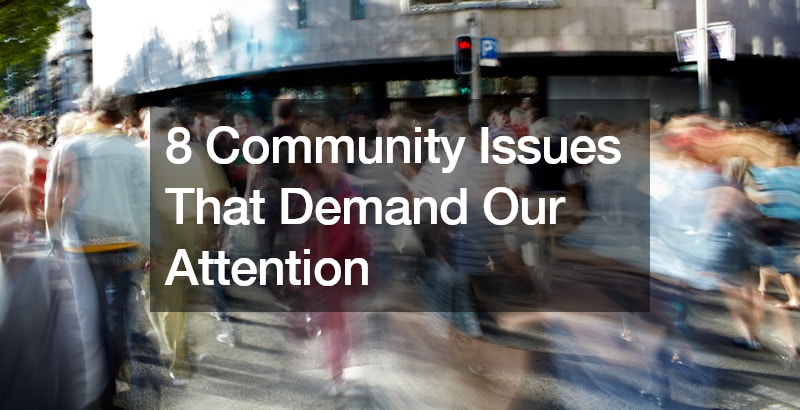In today’s society, we face a slew of problems that affect how people live, impeding the well-being and progress of individuals and communities. From the basic necessity of housing to complex issues such as healthcare access and environmental sustainability, each facet of social welfare warrants meticulous attention and concerted efforts toward improvement. Here are eight critical domains of social welfare we need to improve on to foster a more equitable and sustainable future for all.
1. Housing and Homelessness
Access to stable housing is a fundamental human need, yet soaring costs and systemic barriers have rendered it out of reach for many. In recent years, the issue of housing affordability has reached critical levels, leading to a surge in homelessness across diverse demographics.
Rising Housing Costs:
The surging housing costs have surpassed income growth, leaving many individuals and families struggling to afford decent housing. For example, in metropolitan areas, the gap between wages and housing prices has widened, making it increasingly challenging for low- and middle-income earners to secure affordable accommodation.
Factors Contributing to Homelessness:
Homelessness stems from a complex interplay of factors, including economic hardship, mental health issues, and substance abuse. Consider the case of a young adult experiencing mental health challenges who lacks familial support and finds themselves on the streets, unable to afford housing or access necessary treatment.
Addressing the Crisis:
To combat homelessness effectively, a multifaceted approach is necessary. Firstly, measures should be taken to increase the availability of affordable housing through initiatives such as rent control and subsidized housing programs. Additionally, comprehensive support services, including mental health treatment, substance abuse counseling, and job training programs, should be readily accessible to individuals experiencing homelessness. Homeless teen programs also play a crucial role in providing support and resources to vulnerable youth. These programs offer a lifeline to teenagers who may have fled abusive homes or aged out of foster care, offering them a safe space and access to essential services.
2. Access to Education

Access to quality education is not just a privilege but a fundamental right crucial for societal advancement. However, disparities persist across demographics, with socioeconomic status, geographical location, and systemic biases creating barriers to educational opportunities, particularly for marginalized communities.
Socioeconomic Disparities in Education:
In many regions, children from low-income families face significant challenges in accessing quality education. For example, students attending schools in impoverished neighborhoods often encounter overcrowded classrooms, outdated textbooks, and limited extracurricular opportunities. These disparities perpetuate cycles of inequality, impacting academic achievement and future prospects.
Geographical Barriers to Education:
Geographic location can also determine educational outcomes, with rural communities often lacking access to the same resources and opportunities as their urban counterparts. Remote areas may struggle to attract qualified teachers, offer advanced coursework, or provide adequate transportation for students, further exacerbating educational inequalities.
Importance of Early Childhood Education:
Investing in early childhood education is essential for leveling the playing field and ensuring all children have a strong foundation for learning. Programs such as preschools and day schools not only support cognitive and socio-emotional development but also help narrow the achievement gap between disadvantaged students and their peers.
Equitable School Funding:
Equitable distribution of school funding is critical to addressing disparities in educational resources. Yet, many school districts continue to rely heavily on property taxes, resulting in unequal funding across communities. Initiatives like Title I funding aim to allocate additional resources to schools serving low-income students, but more comprehensive reform is needed to ensure fair distribution of resources.
Enhanced Access to Technology:
In today’s digital age, access to technology is essential for academic success. However, students from underserved communities often lack access to computers, high-speed internet, and digital learning tools. Closing the digital divide requires initiatives to provide devices and broadband access to students, as well as training for educators to integrate technology effectively into the curriculum.
3. Healthcare Access
Ensuring access to healthcare is not only a moral imperative but a fundamental human right. However, millions continue to face barriers that prevent them from obtaining essential medical services. Vulnerable populations bear the brunt of these challenges, often struggling to afford basic healthcare or access healthcare facilities in their communities.
Financial Barriers to Healthcare:
Many individuals and families are deterred from seeking medical care due to high out-of-pocket costs, even with insurance coverage. For instance, patients with chronic conditions may face substantial copayments for medications or medical procedures, leading to financial hardship. In some cases, fundraising for patients has become a necessity, with communities rallying to cover medical expenses through crowdfunding platforms or local fundraisers.
Geographic Challenges:
Access to healthcare is further hindered by geographic barriers, particularly in rural and remote areas where healthcare facilities are scarce. Patients in these regions may have to travel long distances to access specialized care or even basic medical services. This lack of proximity to healthcare providers can delay treatment and exacerbate health disparities, particularly for those with limited mobility or transportation options.
Disparities in Vulnerable Populations:
Low-income individuals, minorities, and other vulnerable populations face unique challenges in accessing healthcare. Language barriers, cultural differences, and distrust of the healthcare system can deter individuals from seeking care, leading to disparities in health outcomes. Additionally, systemic issues such as discrimination and lack of insurance coverage further compound these challenges, leaving many without access to essential medical services.
Policy Interventions for Universal Access:
Policy interventions play a crucial role in ensuring universal access to healthcare. Medicaid expansion, for example, has extended coverage to millions of low-income individuals who were previously uninsured. Community health centers, funded in part by government grants, provide primary care and preventive services to underserved populations, reducing barriers to healthcare access.
4. Healthcare Quality

Marginalized communities frequently experience disparities in healthcare quality, leading to differences in treatment outcomes and patient satisfaction. For example, studies have shown that racial and ethnic minorities often receive lower-quality care compared to their white counterparts, resulting in higher rates of preventable illnesses and adverse health outcomes.
Importance of Patient-Centered Care:
Patient-centered care approaches emphasize the importance of considering patients’ cultural backgrounds, beliefs, and preferences when delivering healthcare services. This includes providing language interpretation services for non-English-speaking patients, respecting cultural practices and traditions, and actively involving patients in decision-making processes regarding their care.
Professional Training and Preventive Care:
Enhancing healthcare quality requires ongoing professional training for healthcare providers to ensure they are equipped with the knowledge and skills necessary to deliver high-quality care to diverse patient populations. Additionally, preventive care measures, such as regular health screenings and vaccinations, play a critical role in maintaining overall health and preventing the onset of chronic diseases.
Ensuring Adequate Medical Supplies:
Access to sufficient medical supplies is essential for delivering timely and effective healthcare services. Shortages of essential supplies, such as personal protective equipment (PPE), medications, and medical skin adhesives, can compromise patient care and contribute to adverse outcomes. During public health crises, such as the COVID-19 pandemic, the demand for medical supplies can outstrip available resources, highlighting the importance of robust supply chain management and emergency preparedness measures.
Effective Disinfection of Hospital Equipment:
Effective disinfection of hospital equipment is crucial for preventing healthcare-associated infections and ensuring patient safety, but it presents several challenges. The challenges of disinfecting hospital equipment include the emergence of drug-resistant pathogens and the need to balance thorough disinfection with equipment durability. For instance, sterilizing complex medical devices such as endoscopes requires meticulous attention to detail and adherence to stringent protocols to mitigate the risk of contamination.
5. Crime and the Justice System

The criminal justice system is plagued by inequities that perpetuate cycles of crime and undermine societal cohesion. Rooted in systemic issues such as poverty and inequality, these inequities disproportionately impact marginalized communities. Implementing meaningful reform, including alternative sentencing measures and community-centered approaches to rehabilitation, is essential for fostering trust and reducing recidivism rates. Criminal defense lawyers play a crucial role in advocating for fair treatment and ensuring access to justice for all individuals.
Systemic Inequities in the Criminal Justice System:
The criminal justice system exhibits systemic biases that disproportionately harm marginalized communities. For example, racial and ethnic minorities are often subjected to harsher sentences than their white counterparts for similar offenses. Moreover, individuals from low-income backgrounds may lack access to quality legal representation, leading to unequal treatment under the law.
Impact on Marginalized Communities:
Crime has a disproportionate impact on marginalized communities, exacerbating existing social and economic disparities. For instance, neighborhoods with high levels of poverty and unemployment often experience higher rates of crime and violence. Moreover, individuals from these communities may face barriers to reintegration after serving their sentences, leading to cycles of incarceration and recidivism.
Need for Meaningful Reform:
Meaningful reform is essential to address the systemic inequities present in the criminal justice system. This includes implementing alternative sentencing measures, such as diversion programs and drug courts, which prioritize rehabilitation over punitive measures. Community-centered approaches that involve stakeholders from affected communities in the decision-making process can also help build trust and foster greater cooperation between law enforcement and the community.
6. Transportation and Infrastructure
Accessible and reliable transportation infrastructure is indispensable for facilitating economic opportunities and fostering social connectivity. However, many communities, particularly those in rural or low-income areas, face significant challenges in accessing reliable transportation options. For example, limited access to public transit services and inadequate road infrastructure can hinder mobility for residents, making it difficult for them to access employment opportunities, healthcare facilities, and essential services.
Investments in Public Transit and Urban Design:
Investing in public transit expansion and pedestrian-friendly urban design is critical for promoting transportation equity. This includes initiatives such as improving bus routes, increasing frequency of service, and enhancing accessibility features for individuals with disabilities. Furthermore, creating safe and walkable urban environments encourages active transportation modes, such as walking and cycling, which can improve public health outcomes and reduce carbon emissions. Incorporating a robust roadside assistance service further ensures the safety and accessibility of transportation networks, providing essential support for motorists experiencing breakdowns or emergencies.
Sustainable Mobility Solutions:
Promoting sustainable mobility solutions, such as electric vehicles and bike-sharing programs, can reduce reliance on fossil fuels and mitigate environmental impacts associated with transportation. These initiatives not only contribute to environmental sustainability but also enhance transportation options for underserved communities, particularly those with limited access to personal vehicles.
Improvements in Airport Transportation:
Improvements in airport transportation services are essential for enhancing accessibility and connectivity for travelers. This includes enhancing shuttle bus services, expanding airport express train routes, and implementing efficient airport taxi systems. By providing reliable and convenient transportation options to and from airports, individuals without personal vehicles can access air travel more easily.
7. Alcohol and Substance Abuse
The opioid epidemic and substance abuse crisis have far-reaching consequences, affecting individuals, families, and communities nationwide. For instance, the misuse of prescription opioids has contributed to a sharp increase in overdose deaths and opioid-related hospitalizations, placing a significant burden on healthcare systems and public resources.
Stigma surrounding substance abuse often prevents individuals from seeking help, leading to delays in treatment and exacerbating health outcomes. Additionally, limited access to affordable and evidence-based treatment programs, particularly in underserved communities, further hinders efforts to address the crisis effectively. Gaps in prevention efforts, such as inadequate education and awareness campaigns, contribute to the perpetuation of substance abuse cycles.
The Importance of a Comprehensive Approach:
Addressing substance abuse and addiction requires a multifaceted approach that encompasses prevention, harm reduction, and treatment initiatives. Prevention efforts may include implementing community-based programs aimed at educating youth about the risks of substance abuse and promoting healthy lifestyle choices. Harm reduction strategies, such as needle exchange programs and supervised injection sites, aim to minimize the negative consequences associated with substance use while connecting individuals to treatment and support services.
The Role of Evidence-Based Treatment:
Evidence-based treatment programs, including medication-assisted therapy and cognitive-behavioral therapy, play a crucial role in supporting individuals on their path to recovery. These programs address the underlying factors contributing to substance abuse and provide comprehensive support to individuals seeking to overcome addiction. Incorporating specialized alcoholism treatment programs into this framework ensures that individuals struggling with alcohol addiction receive tailored care and support to address their unique needs and challenges.
8. Senior Services

With the aging of the population, the demand for senior care services continues to rise, placing strains on existing healthcare and support systems. Seniors often face complex healthcare needs, including chronic conditions and age-related ailments, requiring specialized care and attention. These challenges are compounded by social isolation, limited mobility, and financial insecurity, making the need for senior services dire.
Initiatives to Support Aging in Place:
Many older adults prefer to age in place, remaining in their own homes and communities as they grow older. However, this setup presents challenges related to accessibility and the availability of support services. This is where aging-in-place initiatives enter the picture. Aiming to support seniors in maintaining their independence and quality of life while living in their own homes, these initiatives may include home modification programs to improve accessibility, transportation services to help seniors get around, and social support programs to combat isolation.
Caregiver Support and Elder Abuse Prevention:
Caregiver support programs provide much-needed assistance to family members caring for aging loved ones, offering respite care, counseling, and education on caregiving best practices. Additionally, elder abuse prevention efforts work to raise awareness of the signs of abuse and provide support services for seniors who may be at risk.
Specialized Assisted Living for Seniors:
Incorporating specialized assistance living for seniors into senior care services ensures that older adults have access to safe and supportive living environments tailored to their unique needs. These facilities offer a range of services, including assistance with activities of daily living, medication management, and recreational activities, to promote independence and well-being among seniors.
Closing Thoughts
In confronting the relentless challenges of social welfare, collaboration and collective action are pivotal. By addressing housing insecurity, enhancing educational opportunities, ensuring equitable healthcare access, and tackling systemic injustices, we can lay the foundation for a more just, inclusive, and sustainable society.




